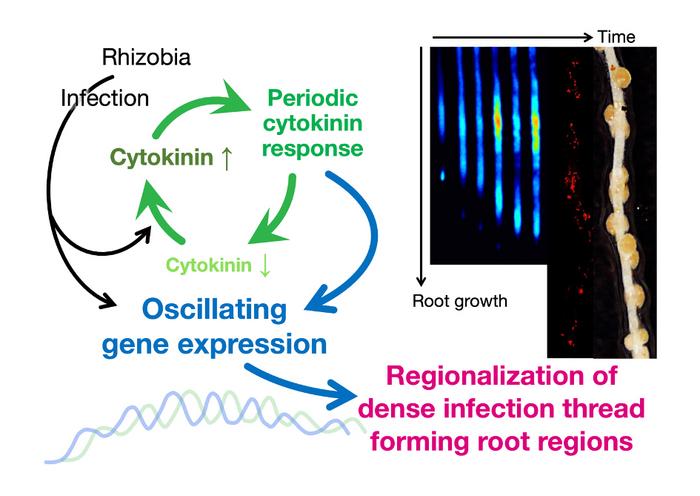Legumes thrive in low-nitrogen environments by partnering with rhizobia, soil bacteria that convert atmospheric nitrogen into ammonium, a usable form for the plants. These beneficial bacteria are housed in root nodules formed on legume roots. However, the uncontrolled formation of numerous root nodules can impede root function. To prevent this, legumes need to regulate the distribution and number of root nodules, but the precise mechanisms were previously unclear.

Credit: NIBB
Legumes thrive in low-nitrogen environments by partnering with rhizobia, soil bacteria that convert atmospheric nitrogen into ammonium, a usable form for the plants. These beneficial bacteria are housed in root nodules formed on legume roots. However, the uncontrolled formation of numerous root nodules can impede root function. To prevent this, legumes need to regulate the distribution and number of root nodules, but the precise mechanisms were previously unclear.
Recent research on Lotus japonicus, a model leguminous plant, has unveiled that the interaction between legume roots and rhizobia is characterized by periodic gene expression with a six-hour rhythm. This rhythmic gene expression influences the regions of the root susceptible to rhizobial infection and the distribution of nodules. It was also discovered that the plant hormone cytokinin is crucial for maintaining this gene expression rhythm. This groundbreaking study, published in Science, is a collaborative effort conducted by the National Institute for Basic Biology, Nara Institute of Science and Technology, Hokkaido University, Kwansei Gakuin University, RIKEN, and Aichi University of Education.
When rhizobia infect legume roots, root epidermal cells form infection threads, membranous tube-like structures guiding the bacteria to the inner root tissue where they can fix nitrogen. Rhizobial infection primarily occurs in a narrow root region just behind the root tip, known as the susceptible region. The continuous cell generation at the root tip perpetually creates new susceptible regions. Ideally, infection threads would be evenly distributed throughout the root. However, closer examination reveals a pattern of densely formed infection threads alternating with sparser regions, suggesting intermittent rather than continuous responses to rhizobia. Detailed studies on the dynamic response of roots to rhizobia over time have been lacking.
Using luminescence live-imaging with luciferase as a reporter, the research team observed that NSP1 gene expression, rapidly induced in response to rhizobia and essential for the infection process, exhibited oscillatory patterns at approximately six-hour intervals in the susceptible region. As the root grew, new expression sites appeared apically to the previous oscillation regions. “We noticed that these oscillation regions coincide with areas where infection threads are densely formed, leading us to think that this rhythmic gene expression might be related to the determination of nodule formation sites,” said Dr. Takashi Soyano, Associate Professor of the National Institute for Basic Biology, a member of the research team. Consistent with this notion, a large population of root nodules was formed in the oscillation region, suggesting a link between rhythmic gene expression and nodule formation. Other genes essential for early responses during nodule symbiosis also displayed oscillatory expression patterns, marking the first evidence of periodic gene expression in response to rhizobia.
Cytokinin, a key regulator in root nodule symbiosis, maintains this oscillatory gene expression. Genes related to cytokinin biosynthesis, metabolism, and signaling exhibited oscillatory expression after rhizobial inoculation. Luminescence imaging using the cytokinin response marker TCSn revealed oscillatory cytokinin responses, aligning with the timing of active cytokinin content fluctuations.
The study utilized mutants of a cytokinin receptor LHK1 to explore cytokinin’s role in gene expression periodicity. In mutants lacking functional LHK1, oscillating intervals of the periodic NSP1 expression were prolonged, expanding the root region where NSP1 expression oscillates. Conversely, in plants transformed with an activated form of LHK1, the induction of NSP1 expression was suppressed, leading to loss of its periodicity. The NSP1 oscillation region coincided with the area forming dense infection threads. The lhk1 loss-of-function mutants exhibited enlarged root segments forming dense infection threads, whereas the active LHK1 reduced infection thread densities. These findings underscore the importance of proper cytokinin response in maintaining the symbiotic oscillation and ensuring appropriate infection thread distribution.
Root nodule symbiosis occurs in the monophyletic nitrogen-fixing clade, including four orders, Fabales, Rosales, Cucurbitales, and Fagales, indicating a shared evolutionary acquisition to interact with nitrogen-fixing bacteria. Among them, the legume family in the order Fabales, where most of the species engaged in root nodule symbiosis, uniquely incorporated the cytokinin pathway as an important regulatory module for the symbiosis. “The discovery of periodic cytokinin responses was unexpected, raising several questions, including the molecular mechanisms that establish this periodicity and how these periodic responses shape the infection regions, ” Dr. Soyano said. Addressing these questions is expected to deepen the understanding of the regulatory mechanisms of root nodule symbiosis and advance research on the spatial control of organ development through periodic responses mediated by plant hormones.
Journal
Science
Method of Research
Experimental study
Article Title
Periodic cytokinin responses in Lotus japonicus rhizobium infection and nodule development
Article Publication Date
19-Jul-2024



